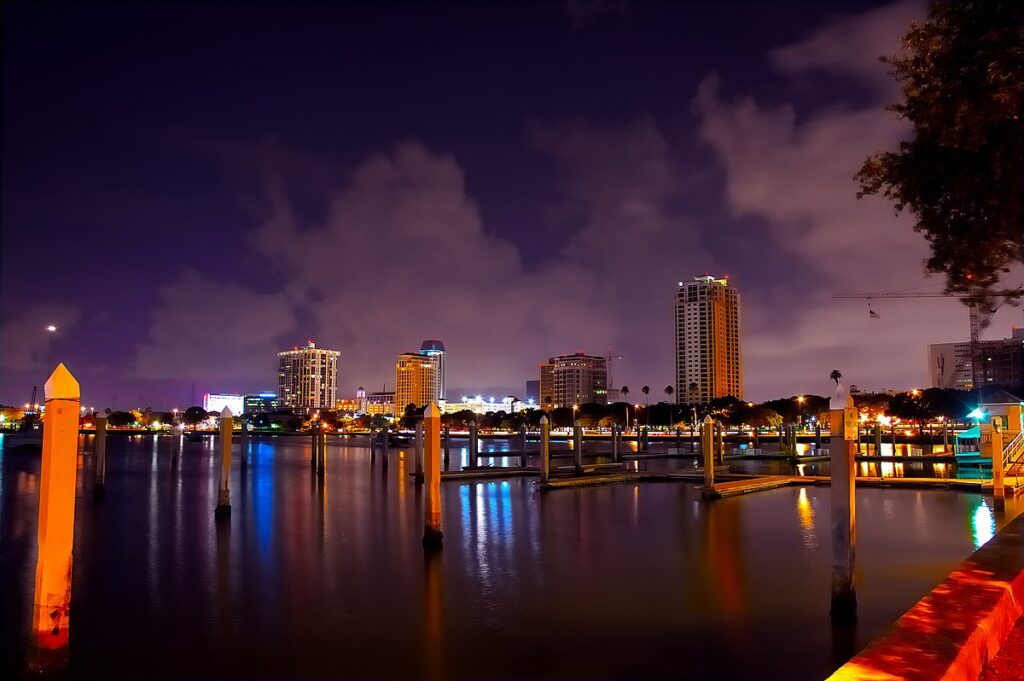
Moving to St. Petersburg, Florida: A Comprehensive Relocation Guide
Considering moving to St. Petersburg, Florida? This vibrant Pinellas County city offers arts culture, waterfront location, and urban energy. With approximately 270,000 residents in 2025, St. Petersburg combines downtown revival with neighborhood character and Tampa Bay’s premier cultural destination.
Demographic Profile to Consider If Moving to St. Petersburg:
St. Petersburg’s 2025 population is approximately 270,000 residents, making it Tampa Bay’s second-largest city. The median age is around 42 years, with young professionals, artists, retirees, and diverse working residents. The population is approximately 62% White, 23% Black or African American, 8% Hispanic. St. Petersburg features a revitalized downtown with museums and entertainment, diverse neighborhoods from historic Old Northeast to artistic Grand Central District to waterfront communities, and miles of waterfront along Tampa Bay and Boca Ciega Bay. The city’s transformation into an arts and culture hub attracts creative professionals and urban dwellers. St. Petersburg appeals to those seeking vibrant city energy with waterfront lifestyle and cultural amenities. The community balances urban development with neighborhood character. Find trusted local services for moving, living, and working in St Petersburg.St Petersburg Relocation Directory
Cost of Living to Consider If Moving to St. Petersburg:
St. Petersburg offers moderate to upper-moderate costs for Tampa Bay area. Median home values range from $350,000 to $550,000 in 2025, varying dramatically by neighborhood from affordable areas to luxury waterfront properties. The median household income is approximately $62,000. Rental properties average $1,700 to $2,800 monthly. Florida’s absence of state income tax benefits residents. Overall cost of living reflects the city’s urban character, waterfront location, and cultural amenities. St. Petersburg attracts diverse income levels from artists to affluent professionals. Housing costs vary significantly from emerging neighborhoods to established waterfront areas. The combination of culture, waterfront, and urban energy drives demand and pricing.
Economy and Job Market:
St. Petersburg’s economy is diverse, including healthcare, financial services, technology, arts, and tourism. Major employers include Bayfront Health St. Petersburg, Johns Hopkins All Children’s Hospital, Raymond James Financial Services, Jabil, and numerous tech companies. The arts sector employs thousands through museums, galleries, and cultural organizations. Tourism supports hospitality employment. The growing downtown attracts startups and creative businesses. Many residents work in professional services, healthcare, technology, and arts. The broader Tampa Bay metro offers vast opportunities. Typical industries include healthcare, finance, technology, arts, and hospitality. The diverse economy provides opportunities at varied skill levels.
Education:
Pinellas County Schools serves St. Petersburg students with numerous schools including St. Petersburg High School, Lakewood High School, and various elementary and middle schools. The large district offers magnet programs and choice schools. School quality varies significantly, requiring family research. Eckerd College offers liberal arts programs. St. Petersburg College campuses provide associate degrees. The University of South Florida St. Petersburg offers four-year programs. The educational infrastructure serves the diverse population.
Recreation and Lifestyle:
St. Petersburg offers world-class cultural amenities including The Dali Museum, Museum of Fine Arts, Chihuly Collection, and Mahaffey Theater. The revitalized downtown features restaurants, breweries, and the Saturday Morning Market. The St. Pete Pier provides waterfront recreation and dining. Beautiful waterfront parks line Tampa Bay. Residents enjoy professional baseball with the Tampa Bay Rays at Tropicana Field. The Grand Central District showcases street art and galleries. Beach access includes St. Pete Beach and Fort De Soto Park nearby. The city hosts First Friday and Second Saturday art walks. The lifestyle emphasizes arts, culture, waterfront recreation, and urban energy. The subtropical climate enables year-round outdoor activities. The community values arts, diversity, urban development, and waterfront lifestyle. The city offers vibrant nightlife, diverse dining, and creative energy.
Healthcare and Services:
St. Petersburg residents access world-class healthcare through Bayfront Health St. Petersburg, Johns Hopkins All Children’s Hospital, and extensive facilities throughout Pinellas County. The Tampa Bay area’s healthcare infrastructure is comprehensive with specialized care in all disciplines. Multiple hospitals and medical facilities serve the region.
Transportation:
St. Petersburg benefits from Interstate 275, Interstate 375, and various corridors. Tampa International Airport is approximately 30 minutes northeast. St. Petersburg-Clearwater International Airport provides additional service. Pinellas Suncoast Transit Authority (PSTA) operates extensive bus routes. The Looper trolley serves downtown. Downtown and some neighborhoods offer walkability. Most residents use personal vehicles. Typical commute times to Tampa range 30-45 minutes.
Conclusion:
Moving to St. Petersburg in 2025 offers vibrant urban living with arts culture, waterfront location, and creative energy. The city’s combination of Dali Museum, revitalized downtown, diverse neighborhoods, and Tampa Bay access makes it ideal for young professionals, artists, and urban dwellers seeking Tampa Bay’s cultural capital where museums meet murals and waterfront beauty complements creative sophistication.

